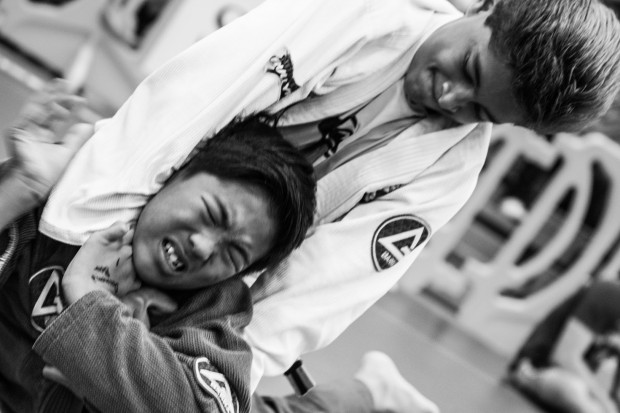4 Tips For More Effective Chokes
Today let’s talk about the principles behind effectively choking our opponents. We often see BJJ students get a choke but struggle to finish the choke and get the tap.
Gi collar strangles or no-gi chokes the most important principles remain the same.
As much as we can learn jiu-jitsu from watching an instructor demonstrate a technique or listen them describe the detail behind a submission technique some of the aspects of jiu-jitsu can only be felt. This is one of the reasons why one can not learn jiu-jitsu effectively from mainly watching YouTube videos. You have to FEEL the weight, tightness and pressure of many techniques to correctly understand them.
This means the BJJ student must experiment and learn to “feel” when they have a good enough grip to successfully choke or if they are just squeezing in a futile effort.
Here are 4 tips to increase your choking success:
1) First hand DEEP in the collar!
When we are teaching collar chokes (especially the cross collar choke from the guard) and a student says that they can’t complete the choke I can usually diagnose the problem without even seeing them attempt the choke. The 1st hand must be deep enough in the collar. If you pay attention to this single detail your chokes will immediately double in effectiveness.
2) You choke with your wrist, not with the gi
The majority of strangles are actually applied by using the sharp bone of your wrist against the neck of the opponent’s neck to cut off blood flow to the brain. The gi itself is usually more of a handle to use as leverage to apply the sharp edge of the wrist to pressure the side of the neck. This is why correct placement of the hand in #1 is so important.

3) There is a difference between a choke and a strangle
A choke (like a guillotine choke) is usually applying pressure directly against the throat of the opponent. It does constrict the airway, but is a little different than a strangle. A strangle (most often used to describe gi “chokes” is when you are applying pressure against the arteries on the side of the neck and preventing fresh oxygenated blood from reaching the brain. When the brain is deprived of oxygenated blood, it shuts off and you go to sleep temporarily. No harm is done to the opponent has just been “choked out”.
4) if it’s not tight, it’s not right!
Whether we are talking about a head and arm choke where the blood is being cut off by the opponent’s own shoulder or the cross collar choke from the mount like Roger Gracie loves,…this rule remains true.
If there is space between where you are applying the pressure and the opponent’s neck, the blood will still be able to reach the brain. This is where you need to develop that “feel” that we first talked about and know how to adjust to remove all of the space to make your choke as tight as possible.
* Tip: Use your other hand to feed the collar to the strangling hand to make sure there is no free space
see also : The Choke – 5 Advanced Strangles
Credits: Mark Mullen
Gracie Barra Black belt based in Saigon, Vietnam
Twitter: @MarkMullenBJJ
